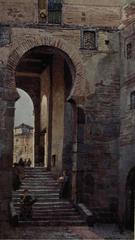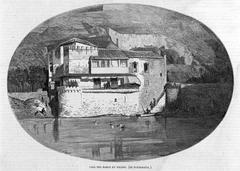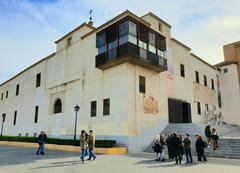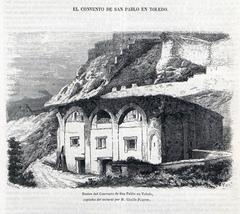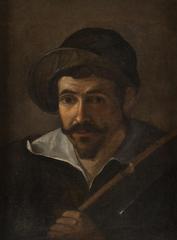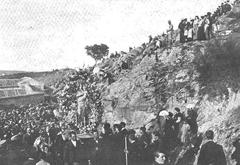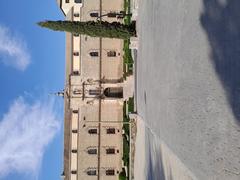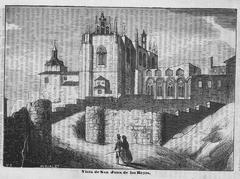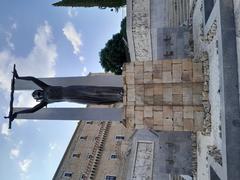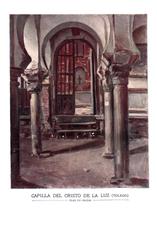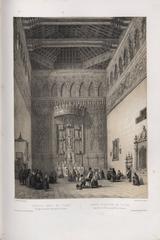
Castillo de San Servando: Visiting Hours, Tickets, and Toledo’s Medieval Heritage
Date: 04/07/2025
Introduction
Perched on a commanding hill above the Tagus River, the Castillo de San Servando is a striking emblem of Toledo’s multicultural and turbulent past. Its imposing walls have witnessed centuries of religious, military, and cultural transformation. Today, the castle not only attracts history enthusiasts and architecture lovers, but also hosts cultural events and offers panoramic views of the city. This guide provides detailed information on visiting hours, ticketing, accessibility, and tips for making the most of your visit, as well as suggestions for exploring nearby historical sites in Toledo.
For further details and official updates, refer to reliable tourism resources (Spain.info, minube, turismoprovinciatoledo.es).
Historical Overview
Early Foundations and Strategic Role
The origins of Castillo de San Servando reach back to the 11th century, when the site was first developed as an Arab fortress to safeguard the vital Alcántara Bridge and the eastern approach to Toledo. After the Christian conquest of Toledo in 1085 under King Alfonso VI, the site transformed into a fortified monastery, reflecting both the religious and strategic imperatives of the era (Spain.info). Its location was pivotal for controlling river and land access, ensuring the city’s defense throughout the medieval period.
Military Transformation and Templar Influence
With the persistent threat of southern incursions, the monastery soon evolved into a robust military fortress. The Knights Templar further reinforced the castle in the late 11th and early 12th centuries, introducing classic medieval defensive elements such as cylindrical towers, crenellated walls, and a fortified gatehouse (minube). These adaptations not only enhanced the castle’s military role but also contributed to its distinctive architectural profile.
Mudejar and Multicultural Architecture
The castle’s architecture reflects the Mudejar style, a harmonious blend of Islamic and Christian motifs. Horseshoe arches, decorative brickwork, and geometric patterns showcase the cross-cultural synthesis that characterized Toledo’s artisanship (Spain.info). The layering of Roman, Visigothic, Muslim, and Christian influences in its construction make Castillo de San Servando a unique testament to the city’s rich heritage.
Later Uses and Modern Status
After the Reconquista, the castle’s military importance waned and it served various roles, including as a noble residence and a barracks. In the 19th century, it was briefly used as a gunpowder warehouse before being declared a National Monument in 1874 (minube). Today, it is preserved as a heritage site, functioning as both a youth hostel and a cultural venue.
Legends and Folklore
Stories of haunted knights and mysterious apparitions add an extra dimension to the castle’s allure, making it a popular subject for guided tours and cultural programs (wikipedia).
Visiting Castillo de San Servando
Visiting Hours
- Tuesday to Saturday: 10:00 AM – 6:00 PM
- Sunday and Holidays: 10:00 AM – 3:00 PM
- Closed on Mondays
Note: Visiting hours may vary for special events or seasonal schedules. Always check the official tourism website or contact the castle directly before your visit.
Ticket Information
- General Admission: €5
- Reduced Admission (students, seniors): €3
- Children under 12: Free
- Special Events: May require advance reservation and have different pricing.
Entry to the grounds is often free, but certain areas, guided tours, or event programs may require tickets. Booking in advance is recommended, especially during peak periods or special reenactments. (ABC)
Accessibility
While efforts have been made to improve accessibility, the historic nature of the site means uneven terrain, stairs, and limited access to certain areas. The exterior gardens and viewpoints are accessible via paved paths. For specific needs, contact the castle or hostel in advance.
Guided Tours and Cultural Experiences
- Regular Guided Tours: Available throughout the year, led by local experts.
- Historical Reenactments: Annual events such as the “Jornadas de Recreación Histórica” bring medieval Toledo to life with camps, artisan workshops, and live demonstrations (Toledo.es).
- Thematic Performances: Theatrical tours, swordsmithing demonstrations, and damasquinado (gold inlay) exhibitions.
- Concerts and Tastings: Occasional music performances and local wine tastings enrich the visitor experience.
Reservations for tours and events are essential due to limited capacity. Some experiences are restricted to adults.
Hostel Accommodation
The castle’s youth hostel offers affordable lodging with basic amenities. Staying overnight allows guests to experience the illuminated fortress after dark—a highlight for many travelers (minube).
How to Get There
- Address: Subida de San Servando, s/n, Toledo 45006, Spain (Trek Zone)
- On Foot: Approx. 10–15 minutes uphill from Toledo’s city center via the Alcántara Bridge.
- By Public Transport: Toledo’s main train station is 1.5 km away. Local buses and taxis are available.
- By Car: Limited parking near the castle—arrive early if driving.
Visitor Tips
- Wear comfortable shoes for walking on cobblestones and inclines.
- Bring water, sun protection, and a hat during summer months.
- Check event schedules and book in advance for guided tours or performances.
- Photography is allowed outdoors; restrictions may apply during certain events or in some interior spaces.
Nearby Attractions
- Alcázar of Toledo: Historical fortress and military museum.
- Puente de Alcántara: Roman-era bridge protected by the castle.
- Museo de Santa Cruz: Regional art and archaeology.
- Plaza de Zocodover: Central square with shops and dining.
- Santa María la Blanca: Former synagogue, now a museum.
Frequently Asked Questions
Q: What are the Castillo de San Servando visiting hours?
A: Tuesday–Saturday 10:00–18:00, Sunday/Holidays 10:00–15:00, closed Mondays.
Q: Are tickets required?
A: Ground access is often free; special events and tours may require tickets or reservations.
Q: Is the castle accessible for people with disabilities?
A: Accessibility is limited due to historic terrain. Contact ahead for details.
Q: Can I stay overnight?
A: Yes, the youth hostel inside the castle offers accommodations; advance booking is recommended.
Q: Are guided tours available?
A: Yes, year-round, with special programs during events and festivals.
Q: What are the best photographic spots?
A: The ramparts overlooking the Tagus River, the Alcántara Bridge, and the illuminated castle at night.
Visuals and Virtual Tours

For virtual tours and more images, visit the official tourism sites and hostel pages.
Plan Your Visit
- Book tours and accommodations early via the official Toledo tourism website or by phone.
- Arrive 10 minutes before your scheduled tour or event.
- Respect the historic site and privacy of hostel guests.
- Check weather forecasts and dress accordingly.
Sources and Further Reading
- Castillo de San Servando Visiting Hours, Tickets & History | Toledo Historical Sites Guide (Spain.info)
- Exploring Castillo de San Servando: Visiting Hours, Tickets, and Toledo Historical Sites (minube)
- Castillo de San Servando Visiting Hours, Tickets, and Must-See Attractions in Toledo (ABC)
- Visiting Castillo de San Servando: Hours, Tickets, History, and Practical Tips for Tourists (Trek Zone)
- II Jornadas de Recreación Histórica Castillo de San Servando-Toledo 1212 (Toledo.es)
Enjoy your visit to Castillo de San Servando and immerse yourself in the living history of Toledo! For more tips, audio guides, and up-to-date event information, download the Audiala app and follow us on social media.








